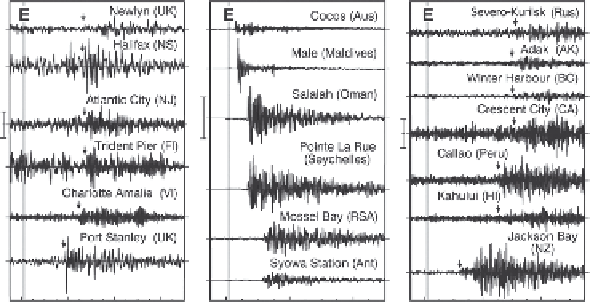Geoscience Reference
In-Depth Information
a large difference in amplitude, confirmed by the results of numerical simulation,
demonstrates a pronounced orientation of the wave energy emission. The data from
other mareographs in the Indian Ocean showed wave amplitudes between 0.5 and
3 m, and no noticeable damping was observed as the distance from the source
increased.
Note that the wave heights measured by mareographs are not always in good
accordance with the tsunami run-up heights on the coast. Several records, ob-
tained from regions with significant run-ups, registered wave heights 2-5 times
smaller, than actually observed values. Thus, for example, the mareograph at Phuket
showed 1.5 m, while the actual run-up height was from 3 to 6 m. This divergence
strongly complicates determination of the true tsunami height on the coast. More-
over, many mareographs in the Indian Ocean were destroyed (Thailand) or happened
to be strongly damaged (Colombo, Sri Lanka). Therefore, the true maximum wave
heights may have remained unknown.
Data on tsunamis in the remote zone revealed that, unlike manifestations near
the source, the maximum wave amplitude was not associated with the leading wave.
In the North Atlantic and at the North of the Pacific Ocean maximum wave heights
were observed with delays from several hours up to several days after the onset of
the tsunami front (Fig. 5.9). It is interesting to note that at Callao (Peru), situated
19,000 km from the source, the waves were higher than on the Coconut islands,
lying significantly closer (1,700 km). Moreover, the tsunami amplitude at Halifax
(Nova Scotia, Canada) was also greater, while in this case the waves had to cross
not only the Indian but also the Atlantic Ocean (longitudinally) and in doing so to
cover over 24,000 km.
Model studies of tsunami propagation in the open ocean permit to obtain a pic-
ture of energy propagation, which cannot be reconstructed having only the data of
26
27
28
29
26
27
28
26
27
28
Fig. 5.9 Time series of tsunami wave heights (cm) as recorded at selected tide-gauge stations in
the three major ocean basins. Arrows indicate first arrival of the tsunami (Reprinted from [Titov
et al. (2005)] by permission of the publisher)








